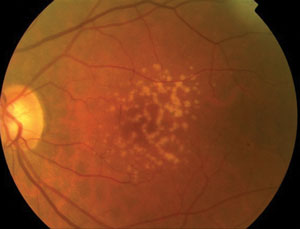A new study found that patients are four times more likely to develop sight-threatening age-related macular degeneration (AMD) if they show signs of medium drusen (63µm to 124µm) plus retinal pigment epithelium (RPE) abnormalities, according to investigators at the University of Sydney in Australia. Their findings were published online in JAMA Ophthalmology.
 |
The team looked at 3,654 participants, 49 years or older, over a span of 15 years. Among the 1,317 participants at risk, the 15-year cumulative incidence of medium drusen was 13.9%.
“In general, the larger the drusen, the higher the risk of progression to late AMD. RPE changes with drusen, whether medium or large, increase the risk further,” explained Carl D. Regillo, MD, director of Retina Service at Wills Eye Hospital and professor of ophthalmology at Thomas Jefferson University in Philadelphia.
Although this study’s results alone probably won’t impact the way doctors follow and treat patients, its implications could nudge optometrists to “potentially follow patients with medium size drusen and pigmentary changes a bit closer, similar to the way we now follow those with large drusen,” Dr. Regillo said.
For Mark T. Dunbar, OD, director of optometry at the Bascom Palmer Eye Institute in Miami, one particular aspect of the study stood out. “Patients who had genetic risk factors [CFH and ARMS2 risk alleles] were even more likely to progress,” he said. “Clinicians can assume that even without genetic testing, the presence of medium drusen and RPE abnormalities signifies a considerably high risk for progression. Therefore, these patients need to be followed more closely with advanced imaging technologies such as SD-OCT and fundus autofluorescence.”
“Patients with medium and large drusen should supplement their diets with an AREDS2 formula [supplement],” Dr. Regillo said. “They should also self-monitor their vision at home on a regular basis and know to report any vision changes promptly.”
Joachim ND, Mitchell P, Kifley A, Wang JJ. Incidence, progression, and associated risk factors of medium drusen in age-related macular degeneration: Findings from the 15-year follow-up of an australian cohort. JAMA Ophthalmol. 2015 Apr 2. [Epub ahead of print].
Pink Eye Hits Primetime But that’s what Jonathan Gording, OD, was asked to do for an episode of ABC’s “The Goldbergs,” which aired April 29.
Dr. Gording, who is in private practice in Los Angeles, fitted Erica (Hayley Orrantia) and Dana (Natalie Lind) Goldberg with 22mm theatrical scleral lenses hand-painted with tiny blood vessels to simulate pink eye. “It was a fun change from Tobradex and follow up in 48 hours,” Dr. Gording joked. |



